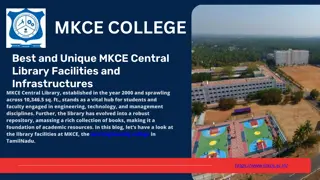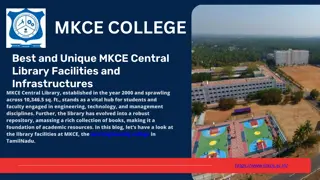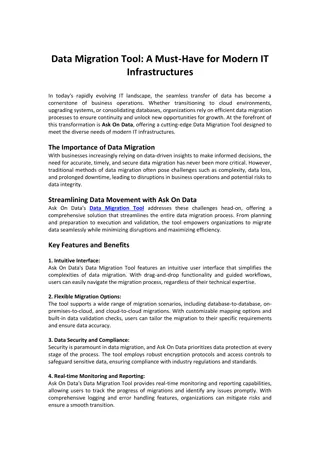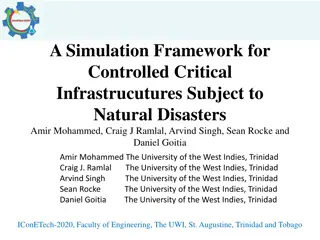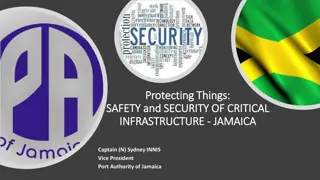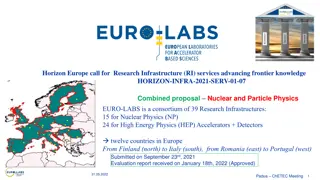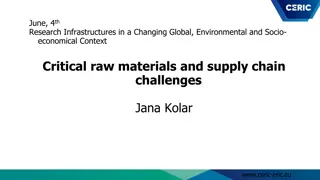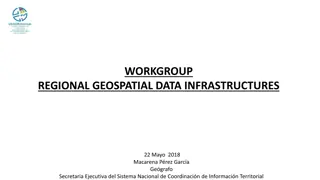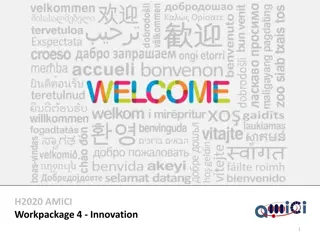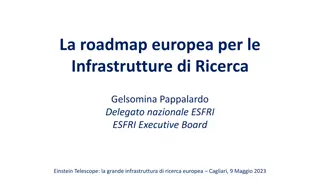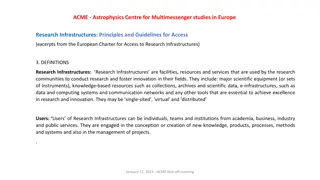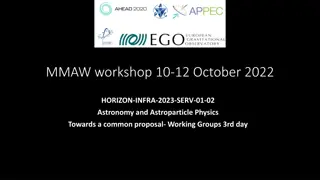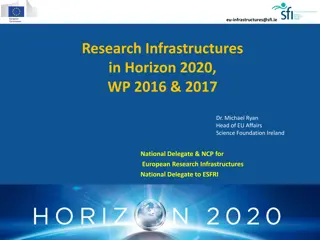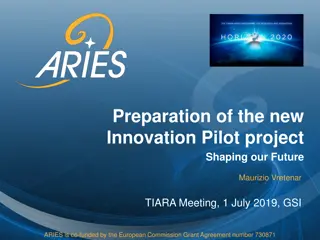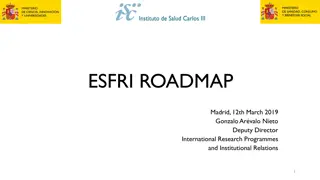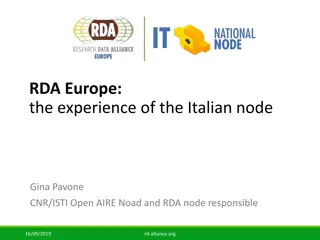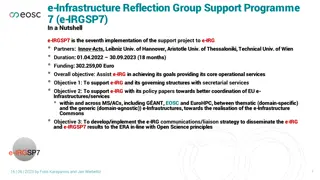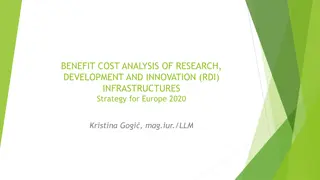COOPEUS Environmental Research Infrastructures
COOPEUS aims to improve coordination between US and EU environmental research infrastructures to enhance scientific productivity and cost-effectiveness. The project focuses on maximizing the utilization of resources and promoting international cooperation in key research areas such as atmospheric radar, ocean observations, biodiversity, solid earth dynamics, and carbon observations. By facilitating collaboration and data-sharing among participating institutions, COOPEUS seeks to advance environmental research on a global scale.
Download Presentation

Please find below an Image/Link to download the presentation.
The content on the website is provided AS IS for your information and personal use only. It may not be sold, licensed, or shared on other websites without obtaining consent from the author.If you encounter any issues during the download, it is possible that the publisher has removed the file from their server.
You are allowed to download the files provided on this website for personal or commercial use, subject to the condition that they are used lawfully. All files are the property of their respective owners.
The content on the website is provided AS IS for your information and personal use only. It may not be sold, licensed, or shared on other websites without obtaining consent from the author.
E N D
Presentation Transcript
COOPEUS Background 1) SYMPOSIUM ON TRANSATLANTIC EU-U.S. COOPERATION IN THE FIELD OF LARGE SCALE RESEARCH INFRASTRUCTURES October 1, 2010 And 2) Meeting at the Annual AAAS Conference in February 2011 GEPW-7 Barcelona, April 15-16
COOPEUS Background How can coordination in use of US and EU Environmental Research Infrastructures be improved to maximize scientific productivity and cost effectiveness? Presentation by T. Killeen, NSF GEPW-7 Barcelona, April 15-16
COOPEUS VISION COOPEUS has to contribute to roadmapping processes by providing relevant scientific information Forward-looking strategic thinking about infrastructures ESFRI Brochure: European Research Infrastructures with global impact Some examples from the ESFRI Roadmap GEPW-7 Barcelona, April 15-16
COOPEUS VISION CAVEATS Infrastructures are very costly and the funding available for non- infrastructure oriented research necessarily shrinks. One should try to preserve the ability to respond quickly and creatively to new discoveries Roadmapping can be a victim of its own success .... If an attempt is made to set priorities across disparate fields a loss of specificity and focus can occur and the outcomes of the exercise could become less actionable . OECD Global Science Forum, Report on Roadmapping of Large Research Infrastructures, December 2008 GEPW-7 Barcelona, April 15-16
COOPEUS Background FP7-INFRASTRUCTURES Duration: 09/2012 08/2015 Project full title: "Strengthening the cooperation between the US and the EU in the field of environmental research infrastructures" SCOPE: Expand the International cooperation between the EU and the USA on common data policies and standards relevant to environmental Research Infrastructures Opportunity: Partners will set focus areas priorities GEPW-7 Barcelona, April 15-16 6
COOPEUS Participating Environmental Research Infrastructures: Focus Area EU USA Atmospheric radar Eiscat AMISR Ocean observations EMSO OOI Biodiversity Lifewatch DataOne Solid Earth dynamics EPOS IRIS/UNAVCO Carbon observations ICOS NEON GEPW-7 Barcelona, April 15-16 7
COOPEUS Consortium EU Partners UNIVERSITAET Bremen (Uni-HB) (the Coordinator) - ISTITUTO NAZIONALE DI GEOFISICA E VULCANOLOGIA (INGV) EISCAT SCIENTIFIC ASSOCIATION (EISCAT) COMMISSARIAT A L ENERGIE ATOMIQUE ET AUX ENERGIES ALTERNATIVES (CEA) AGENCIA ESTATAL CONSEJO SUPERIOR DE INVESTIGACIONESCIENTIFICAS (CSIC) KONINKLIJK NEDERLANDS METEOROLOGISCH INSTITUUT (KNMI) ILMATIETEEN LAITOS (FMI) UNIVERSITA DEGLI STUDI DELLA TUSCIA (Unitus) MARINE INSTITUTE (MI) Partners from USA UNIVERSITY OF WASHINGTON (UW) WOODS HOLE OCEANOGRAPHIC INSTITUTION (WHOI) THE REGENTS OF THE UNIVERSITY OF CALIFORNIA (SCRIPPS) NATIONAL ECOLOGICAL OBSERVATORY (NEON) INCORPORATED RESEARCH INSTITUTIONS FOR SEISMOLOGY NON-PROFIT CORPORATION (IRIS) UNAVCO INC (Unavco) Advanced Modular Incoherent Scatter Radar (AMISR) DataONE GEPW-7 Barcelona, April 15-16 8
COOPEUS Framework - Overall Structure - Workflow Identify Need and Rationale Establish implementation rules Testbeds Policies Prioritize themes Core Legal issues Standards Select use cases Give recommendation for implementation GEPW-7 Barcelona, April 15-16 9
COOPEUS framework: COOPEUS is based on a Bottom-up approach built on existing infrastructures with substantial experience from ongoing transatlantic collaborations. Example: IRIS earthquake browser which shares data from many RIs including COOPEUS partner EPOS/ORFEUS 10 GEPW-7 Barcelona, April 15-16
The Challenge In a technical sense, easy access to distributed computing infrastructures is assumed However, the entire process of DISCOVERY, ACCESS and USE has to be enhanced for users Human Players Consumers Facilitators Providers Data Terminology Metadata Data Infrastructure Semantics Structure Syntax System Key reason for the issue: Large amount and variety of data and diversity of users Dimension of information mediation GEPW-7 Barcelona, April 15-16 11
The Challenge Ubiquitous use of data leads to new requirements as data and information are used in other contexts (semantic interoperability) understanding the state of knowledge in other domains With advances in interoperability, the focus is shifting from heterogenity in system, syntax and structure to semantics GEPW-7 Barcelona, April 15-16 12
Addressing the Challenges Architectures have to be: Interoperable, Scalable, Extensible and Adaptable Using a Brokering Approach Geographic and environmental information systems are calling for integration of metadata and vocabularies Information brokering is providing arbitration between user and provider GEPW-7 Barcelona, April 15-16 13
Impacts and Benefits IMPACTS Better information resource discovery and access Semantics and metadata facilitate understanding across disciplines domain knowledge is more accessible COOPEUS will: stimulate in-domain and cross-domain collaborations, identify best practices, standards and demonstrate brokering applications through use cases Identify essential components for effective collaboration GEPW-7 Barcelona, April 15-16 14
Relation to GEOSS COOPEUS partners are actively contributing to GEOSS tasks COOPEUS will make use of existing GEOSS initiatives and community networks GEOSS is seen as a model to learn how to organize international collaborations and to be aware of potential pitfalls GEPW-7 Barcelona, April 15-16 15
Relation to GEOSS Being an international endeavor, COOPEUS will built up on experience collected within GEOSS GEOSS is offering tools to demonstrate the effectiveness of international collaboration GEOSS Geohazard Supersites COOPEUS is meant to work on data policies and IPR issues that will help to facilitate the data ingestion within GEOSS GEPW-7 Barcelona, April 15-16 16
CONCLUSIONS COOPEUS is meant to explore benefits of transatlantic and cross-disciplinary cooperations in the field of environmental research infrastructures will produce new concepts on how to consolidate knowledge and information to enable cross-disciplinary use Exploring standards and brokering approach to improve multidisciplinary research GEPW-7 Barcelona, April 15-16 17
Further information on COOPEUS project HTTP://WWW.COOPEUS.EU GEPW-7 Barcelona, April 15-16 18


